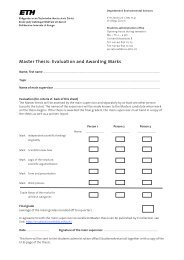The Paradigm of Human-Environment Systems - Natural and Social ...
The Paradigm of Human-Environment Systems - Natural and Social ...
The Paradigm of Human-Environment Systems - Natural and Social ...
Create successful ePaper yourself
Turn your PDF publications into a flip-book with our unique Google optimized e-Paper software.
Table 2 (continued)<br />
<strong>The</strong> <strong>Paradigm</strong> <strong>of</strong> <strong>Human</strong>-<strong>Environment</strong> <strong>Systems</strong><br />
Hierarchy<br />
level<br />
Definition Example Regulatory Mechanism (examples only)<br />
Society A historically established association Western,<br />
containing interrelated, interdepend- eastern<br />
ent parts, which are social structures<br />
or subsystems (see (i) to (iv) <strong>and</strong> institutions<br />
(Parsons, et al., 1951).<br />
society<br />
(i) Economic subsystem: Facilities, Market Regulatory mechanisms related to market<br />
measures <strong>and</strong> transactions that relate economy economies:<br />
to the production, trade <strong>and</strong> consumption<br />
<strong>of</strong> goods<br />
Centrally<br />
planned<br />
• Emission charges (Hanley et al., 1997), Subsidies,<br />
market permits (Crocker, 1996; Dales,<br />
economy<br />
Barter<br />
economy<br />
1968), etc. (primary feedback loop)<br />
(ii) Legal system: Normative rules <strong>and</strong> Roman Constitution, laws, norms, <strong>and</strong> decrees (e.g.,<br />
societal conventions required for law environmental regulation <strong>and</strong> decrees; goal<br />
keeping upright a society. It includes<br />
laws, conventions <strong>and</strong> practices<br />
within a society<br />
Anglo-<br />
Saxon law<br />
formation, strategy selection, secondary feedback<br />
loop)<br />
(iii) Political system: Characterizes the Democ- • Regulation occurs through the release <strong>of</strong> laws<br />
regime <strong>and</strong> the authoritative strucracy or implementation <strong>of</strong> market mechanisms<br />
ture <strong>of</strong> a society<br />
Dictatorship<br />
Oligarchy<br />
(iv) Cultural system: Reflects prefer- Swiss • Guided variation: learning <strong>and</strong> rational calculaences<br />
<strong>and</strong> values <strong>of</strong> a society in language,<br />
science <strong>and</strong> art. <strong>The</strong> bases are<br />
the moral, ethical <strong>and</strong> religious stan-<br />
French<br />
American<br />
tion in response to environmental changes (information<br />
as driving factor), strategy selection,<br />
primary feedback loop<br />
dards <strong>of</strong> a society.<br />
• Biased transmission: selection <strong>of</strong> information<br />
<strong>and</strong> strategies based on specific preferences<br />
(e.g., satisfaction)<br />
• <strong>Natural</strong> selection: dying <strong>of</strong> culture because<br />
they selected the wrong strategy (secondary<br />
feedback loop)<br />
Institutions: Persistent practices, Marriage, Institutionalization: process <strong>of</strong> establishing an<br />
relationships <strong>and</strong> organizations in the EPA, court, organizations <strong>and</strong> functions that strengthen <strong>and</strong><br />
life <strong>of</strong> society that center on funda- banks, maintain societal structures<br />
mental needs, activities, values <strong>of</strong> govern-<br />
cardinal position for maintaining ment,lan- society. Manifested by social regulatory<br />
agencies (Websters, 1993). We<br />
differentiate legal, economic , political<br />
<strong>and</strong> cultural institutions<br />
guage,<br />
ETH-UNS Working Paper 37 11

















